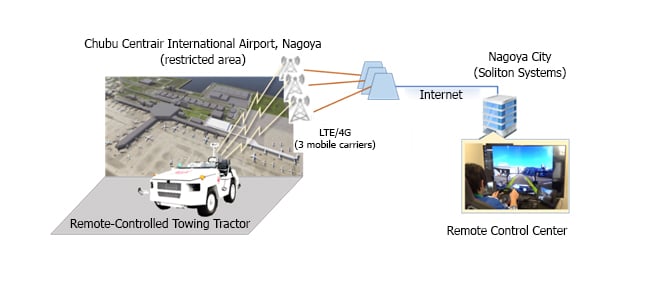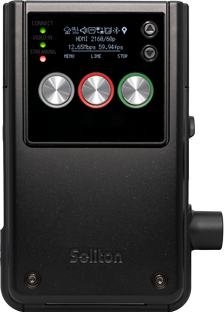Soliton’s OEM Technology for Teledriving Solutions
Teledriving is a relatively new concept of remote driving. Not to be confused with the self-driving car, Teledriving allows vehicles to be “driverless” with the vehicle been driven from a remote teleoperation center by a “teledriver”. A human remains in full control of its operation albeit remotely.
It is expected to gain certification to operate on the public streets in the not-too-distant future where it can be used for applications such as affordable door-to-door taxi services, or where an autonomous vehicle needs to “phone-home” as its current programming cannot resolve a unique situation and needs assistance to continue.
A whole industry has evolved around this subject called micro-mobility, that includes companies such as Triggo. These companies are offering environmentally sustainable transport vehicles especially for robo-taxi and car sharing systems.
Soliton has been actively involved in developing highly reliable elements of the solution that is core to delivering a complete remote driving solution. The teledriver, who sits in a mockup car console with its steering controls, looks at monitors around them that gives them the view from the car as if they are looking through the windscreen, mirrors and side windows. If the teledriver is to operate the car safely, then it’s imperative that the view they receive is in real-time. A delay of even a few hundred milliseconds could prove fatal, given the time it would take for the driver to pull out safely into traffic or to react to an emergency such as a child running into the road.
Soliton’s unique Zao technology can provide live video streams from the car back to the teledriver in less than 100ms. It does this using bonded cellular connections and its own RASCOW2 technology.
By bonding together multiple 4G and 5G connections, it is possible to create a single virtualized network link based on multiple links with different cellular operators simultaneously for extreme reliability and high bandwidth. This is utilized for live streaming video back to the teleoperator. As the Zao technology can provide two-way communication, it operates bi-directionally. In one direction from the car to the teledriver is the ultra-low latency live video streaming from multiple cameras in the car, and the second is a secure IP network connection that sends the commands back from the teledriver to control the car for real time operation.
Ultra-low latency of video transmission from a remote location back to the teleoperator is a key feature of Soliton’s technology. Other bonding systems typically have latencies of 1 to 2 seconds. Even over 4G, Soliton can uniquely achieve latencies of 65ms and below, including both encoding and decoding. With 5G, this latency can be further reduced.
Soliton’s technology is being adopted by teledriving companies and automotive companies that seek to implement reliable and low-latency solutions. As video becomes increasingly important for car communication, it is crucial that the technology is cloud and MEC-ready.
The Zao technology does not rely on expensive 360-degree lidar sensors, nor does it have the requirement of collecting massive amounts of lidar data, making it less expensive and easier to implement.
Soliton Systems has fulfilled innovative driving trails for use in airports with towing baggage tractors, where baggage is remotely driven to the airplane from the terminal without the need for a localized driver. An existing Japan Airlines (JAL) baggage tractor was modified with remote equipment to make it “driverless” within the restricted area of Chubu International Airport with the co-operation of Japan Airlines Co., Ltd. (JAL) and Chubu Sky Support Co., Ltd. (CSS).

The teledriving center set-up in Nagoya city will be responsible for the remote operation of this vehicle where CSS employees, who are qualified to drive at Chubu International Airport, will take responsibility for driving remotely the vehicles. However, the remote drivers ultimately can be located anywhere in the world. With good cellular connectivity, they achieve ultra low latencies with the tractors for safe remote driving in real-time. This is a good example of remote driving where airports are keen to reduce the number of people located within a restricted airport area.

The same principle of remote operation of vehicles can also be applied to other similar scenario’s such as remote control of cranes, unmanned ground vehicles (UGV's), diggers, forklift trucks, and mine clearing equipment. Where there is a war zone or hazardous area that is unfit or dangerous to work, by utilizing the Zao ultra-low latency video streaming equipment, it is possible to take the human element out of the high-risk areas where equipment that would normally need a human operator. The machinery can be remotely controlled and driven from the safety of a teleoperation center that could be anywhere in the world.
If you wish to learn more about the potential of utilizing the Zao live streaming technology within your Tele-driving set-up, then please contact us.
Trails have been conducted for the remote operation of baggage cars at airports. Please read more about it here: - Driverless Baggage Tractors At Airports

0.04 seconds latency - changing the game in live video transmission

The car can be driven from a remote location in a car simulator that is connected to view the road ahead via multiple cameras with almost zero latency.

Driving requires a real time view of the road, the remote driving showing the time delay between the driver and the remote driven car.